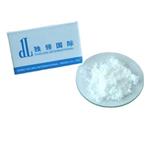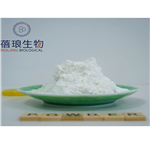- Zanamivir
-

- $0.00 / 10mg
-
2024-04-10
- CAS:139110-80-8
- Min. Order: 10mg
- Purity: 90%+
- Supply Ability: 10g
- ZANAMIVIR HYDRATE
-

- $100.00 / 1kg
-
2023-03-22
- CAS:139110-80-8
- Min. Order: 1kg
- Purity: 99%
- Supply Ability: 20 tons
- ZANAMIVIR HYDRATE
-

- $9.90 / 10g/Bag
-
2022-02-23
- CAS:139110-80-8
- Min. Order: 10g/Bag
- Purity: 99.99%HPLC.USP42——Powder、Oil、Pills、Capsules、Tablets,Customiz
- Supply Ability: 1000kg/Month
|
| | ZANAMIVIR HYDRATE Basic information |
| | ZANAMIVIR HYDRATE Chemical Properties |
| Melting point | 2560C (dec.) | | alpha | D20 +40.9° (c = 0.9 in water) | | density | 1.75±0.1 g/cm3(Predicted) | | storage temp. | 2-8°C | | solubility | H2O: soluble10mg/mL, clear | | form | powder | | pka | 3.82±0.70(Predicted) | | color | white to beige | | optical activity | [α]/D +30 to +40°, c = 1 in H2O | | Water Solubility | Soluble to 5 mM in water | | Stability: | Hygroscopic | | InChIKey | ARAIBEBZBOPLMB-UFGQHTETSA-N | | CAS DataBase Reference | 139110-80-8 |
| | ZANAMIVIR HYDRATE Usage And Synthesis |
| Description | Zanamivir was launched as Relenza in Australia for treatment of human
influenza A and B virus infections. Zanamivir (4-guanidino-Neu5Ac2en) can be
obtained by several similar ways, for instance in seven step synthesis starting
from N-acetyI-D-neuraminic acid. Mechanistically, Zanamivir is a potent and
specific inhibitor of neuraminidase (or sialidase), a key viral surface
glycohydrolase essential for viral replication and disease progression by
catalyzing the cleavage of terminal sialic acid residues from the glycoprotein.
The in vitro activity of Zanamivir against a wide variety of influenza A and B
strains was demonstrated in different model systems; its activity against
clinically relevant isolates of influenza virus, with IC50 values ranging from 0.005
to 15 pM was superior to those of amantadine and rimantadine. | | Chemical Properties | Colorless Crystalline Solid | | Originator | Biota Scientific
Management (Australia) | | Uses | Influenza viral neuraminidase inhibitor; structural analog of the sialic acid. Antiviral | | Uses | antineoplastic, anti-metabolite | | Uses | ZANAMIVIR HYDRATE is a sialic acid analog that inhibits neuraminidase release of newly replicated influenza virus particles. It has been shown to selectively inhibit the growth of influenza A and B viruses in plaque reduction assays with IC50 values ranging from 5 to 14 nM and to directly inhibit influenza A and B virus neuraminidases with IC50 values ranging from 0.6 to 7.9 nM in vitro. The efficacy and tolerabilbity of zanamivir has also been established in clinical trial.[Cayman Chemical] | | Definition | ChEBI: Zanamivir is a member of guanidines. It has a role as an EC 3.2.1.18 (exo-alpha-sialidase) inhibitor and an antiviral agent. | | Indications | Zanamivir (Relenza) is a neuraminidase inhibitor with
activity against influenza A and B strains. Like oseltamivir,
zanamivir is a reversible competitive antagonist
of viral neuraminidase. It inhibits the release of
progeny virus, causes viral aggregation at the cell surface,
and impairs viral movement through respiratory
secretions. Resistant variants with hemagglutinin and/or
neuraminidase mutations have been produced in vivo;
however, clinical resistance to zanamivir is quite rare at
present. | | Manufacturing Process | The 1st method of preparation of zanamivir:
5-(Acetylamino)-4-amino-2,6-anhydro-3,4,5-trideoxy-D-glycero-D-galacto-
non-2-enonic acid (3 g, 10.35 mmol) was suspended in methanol (37.5 ml)
and sodium acetate (1.89 g, 23.1 mmol) was added, causing a "caking" of the
suspension and making stirring difficult. To this at 21°C with exclusion of
moisture was added a solution of cyanogen bromide (1.14 g, 10.8 mmol) in
methanol (150 ml), in a dropwise manner. Stirring gradually became easier,
until a readily stirrable suspension was obtained. Addition was complete in 3.5
hours. The mixture was then stirred at 21°C with exclusion of moisture for 44
hours. The small amount of remaining solid was filtered off and solvent
evaporated in vacuo to an orange-brown foam. The foam was taken up in
methanol (125 ml) and with rapid stirring at 21°C was treated dropwise with
propan-2-ol (130 ml). The precipitate was filtered off, washed with iso-
PrOH/MeOH (3:2), and combined filtrate and washings evaporated to give the
5-(acetylamino)-4-cyanoamino-2,6-anhydro-3,4,5-trideoxy-D-glycero-D-
galacto-non-2-enonic acid as a pale yellow foam (3.48 g).
5-(Acetylamino)-4-cyanoamino-2,6-anhydro-3,4,5-trideoxy-D-glycero-D-
galacto-non-2-enonic acid (500 mg, 1.59 mmol) was dissolved in dried (over
3 A mol. sieves) methanol (20 ml) and anhydrous hydrazine (0.5 ml, 15.9
mmol) was added. This was then stirred at 21°C for 18 hours. The white
precipitate was filtered off, washed with methanol and air-dried (0.172 g,
31%). The solid was taken up in water (3.2 ml) and with warming and
swirling, propan-2-ol (8.1 ml) was added. The cystallised material was filtered
off, air-dried then dried under high vacuum to give D-glycero-D-galacto-non-
2-enonic acid, 5-(acetylamino)-4-(aminoiminomethyl)amino)-2,6-anhydro-
3,4,5-trideoxy as a white solid (0.127 g,); >97% purity; M.P. >180°C.
The 2nd method of preparation of zanamivir:
5-(Acetylamino)-4-cyanoamino-2,6-anhydro-3,4,5-trideoxy-D-glycero-D-
galacto-non-2-enopyranosonic acid (500 mg, 1.585 mmol) was dissolved in
dried (over 3 A mol. sieves) methanol (12 ml) and methylamine (33 wt. %
solution in ethanol, 1.93 ml, 15.85 mmol) was added. This was stirred at
21°C for 18 hours. The precipitate was filtered off and air dried to a white
solid (127 mg, 23%). This was recrystalIised from water (1.4 ml) and propan-
2-ol (6.9 ml). The product was filtered off and dried under high vacuum to
give the title compound as a white solid (56 mg, 10.2%). Concentration of
mother liquors gave a further 21.3 mg (4%) of D-glycero-D-galacto-non-2-
enonic acid, 5-(acetylamino)-4-(aminoiminomethyl)amino)-2,6-anhydro-3,4,5-
trideoxy-; 97.7% purity; M.P. >180°C. | | Brand name | Relenza (GlaxoSmithKline). | | Therapeutic Function | Antiviral | | Acquired resistance | Resistance is presently uncommon, including strains resistant
to oseltamivir. In clinical trials the frequency was no more
than 1% of exposed patients. | | General Description | Zanamivir is identical to 2-deoxy-2,3-dehydro-N-acetylneuraminic acid except that itpossesses a guanidino group at position 4 instead of a hydroxylgroup. At positions 119 and 227 of the receptor site,there exist glutamic acid residues. Zanamivir has beenshown to form a salt bridge with the guanidine and Glu-119and a charge transfer interaction with Glu-227. These interactionsincrease the interaction strength with the enzymeand create an excellent competitive inhibitor and an effectiveantiviral agent for influenza types A and B.
Human studies have shown that zanamivir is effectivewhen administered before or after exposure to the influenzavirus. If administered before exposure to the virus, the drugreduced viral propagation, infectivity, and disease symptoms.If administered after exposure, the drug reduces propagation,viral titer, and illness. Zanamivir is marketed as a dry powderfor oral inhalation. It is used in adolescents and adults who have been exposed and are symptomatic for not more than 2days. Zanamivir is also indicated for prophylactically treatingfamily members of a person who has developed influenza. | | Pharmaceutical Applications | A synthetic neuraminidase inhibitor formulated for administration
by inhalation. | | Biochem/physiol Actions | Zanamivir is an influenza viral neuraminidase inhibitor. | | Pharmacology | Zanamivir is generally well tolerated. Bronchospasm
and impaired lung function have been reported in some
patients taking this medication, but many of these individuals
had serious underlying pulmonary disease.
Zanamivir should be discontinued if an individual develops
bronchospasm or breathing difficulties; treatment
and hospitalization may be required. Allergic reactions,
including angioedema, have been rarely
reported. The efficacy of zanamivir depends upon the
proper use of the inhaler device. | | Pharmacokinetics | Oral bioavailability is poor. After inhalation local respiratory
mucosal concentrations greatly exceed those that are inhibitory
for influenza A and B replication. The median concentrations
in the sputum exceed 1 mg/L 6 h after inhalation and
remain detectable for 24 h. | | Clinical Use | Treatment of influenza A and B infections in patients over 7 years of age,
and prophylaxis of patients ??5 years of age | | Clinical Use | Zanamivir is indicated for treatment of uncomplicated
acute influenza A and B virus in patients aged 7 and
older.Treatment should be initiated no later than 2 days
after the onset of symptoms. Zanamivir shortens the duration
of illness by 1 to 1.5 days. It is also an effective
prophylaxis against influenza; however, the FDA has
not approved this indication at the time of publication. | | Side effects | Zanamivir is contraindicated in individuals with severe
or decompensated chronic obstructive lung disease
or asthma because it has not been shown to be effective
in these individuals and can cause serious adverse pulmonary
reactions. Individuals with mild to moderate
asthma may have a decline in lung function when taking
zanamivir. The safety and efficacy of this medication
have not been determined in individuals with severe renal
insufficiency. No clinically significant drug interactions
have been reported. Zanamivir does not decrease
the effectiveness of the influenza vaccine. | | Side effects | Most adverse effects are related to the respiratory tree. These
include rhinorrhea and, rarely, bronchospasm. Nausea and
vomiting have been reported at low incidence. | | Metabolism | Zanamirvir is effective when administered via the nasal, intraperitoneal, and intravenous (IV) routes, but it is inactive when given orally. Animal studies have shown 68% recovery of the drug in the urine following intraperitoneal administration, 43% urinary recovery following nasal administration, and only 3% urinary recovery following oral administration. Human data gave results similar to those obtained in animal models. Human efficacy studies with nasal drops or sprays demonstrated that the drug was effective when administered before and after exposure to influenza A or B virus. When given before viral inoculation, the drug reduced viral shedding, infection, and symptoms. When administered beginning at either 26 or 32 hours after inoculation, there was a reduction in shedding, viral titer, and fever. | | storage | Store at -20°C | | references | [1] elliott m. zanamivir: from drug design to the clinic. philos trans r soc lond b biol sci, 2001, 356(1416): 1885-93. |
| | ZANAMIVIR HYDRATE Preparation Products And Raw materials |
| Raw materials | Cyanogen bromide-->HYDRAZINE-->Methylamine-->Sodium acetate-->149398-58-3-->Carbamimidothioic acid, N-acetyl-, methyl ester-->1H-Pyrazole-3-carboximidamide Hydrochloride-->D-glycero-D-galacto-Non-2-enonic acid, 5-(acetylamino)-4-[(aminoiminomethyl)amino]-2,6-anhydro-3,4,5-trideoxy-, methyl ester, 7,8,9-triacetate-->4-amino-2-deoxy-2,3-didehydro-N-acetylneuraminic acid-->Zanamivir-->1H-Pyrazole-1-carboxamidine hydrochloride-->methyl (3aR,4R,7aR)-2-methyl-4-(1S,2R,3-triacetoxypropyl)-3a,7a-dihydro-4H-pyrano[3,4-d]oxazole-6-carboxylate-->AMinoiMinoMethanesulfonic Acid |
|